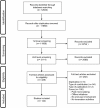What Online User Innovation Communities Can Teach Us about Capturing the Experiences of Patients Living with Chronic Health Conditions. A Scoping Review
- PMID: 27272912
- PMCID: PMC4896620
- DOI: 10.1371/journal.pone.0156175
What Online User Innovation Communities Can Teach Us about Capturing the Experiences of Patients Living with Chronic Health Conditions. A Scoping Review
Abstract
Background: In order to adapt to societal changes, healthcare systems need to switch from a disease orientation to a patient-centered approach. Virtual patient networks are a promising tool to favor this switch and much can be learned from the open and user innovation literature where the involvement of online user communities in the innovation process is well-documented.
Objectives: The objectives of this study were 1) to describe the use of online communities as a tool to capture and harness innovative ideas of end users or consumers; and 2) to point to the potential value and challenges of these virtual platforms to function as a tool to inform and promote patient-centered care in the context of chronic health conditions.
Methods: A scoping review was conducted. A total of seven databases were searched for scientific articles published in English between 1995 and 2014. The search strategy was refined through an iterative process.
Results: A total of 144 studies were included in the review. Studies were coded inductively according to their research focus to identify groupings of papers. The first set of studies focused on the interplay of factors related to user roles, motivations, and behaviors that shape the innovation process within online communities. Studies of the second set examined the role of firms in online user innovation initiatives, identifying different organizational strategies and challenges. The third set of studies focused on the idea selection process and measures of success with respect to online user innovation initiatives. Finally, the findings from the review are presented in the light of the particularities and challenges discussed in current healthcare research.
Conclusion: The present paper highlights the potential of virtual patient communities to inform and promote patient-centered care, describes the key challenges involved in this process, and makes recommendations on how to address them.
Conflict of interest statement
Similar articles
-
Views of Community Managers on Knowledge Co-creation in Online Communities for People With Disabilities: Qualitative Study.J Med Internet Res. 2017 Oct 10;19(10):e320. doi: 10.2196/jmir.7406. J Med Internet Res. 2017. PMID: 29017993 Free PMC article.
-
Beyond the black stump: rapid reviews of health research issues affecting regional, rural and remote Australia.Med J Aust. 2020 Dec;213 Suppl 11:S3-S32.e1. doi: 10.5694/mja2.50881. Med J Aust. 2020. PMID: 33314144
-
Profile of Innovative Ideas Recorded by Nurses in an Ideas Bank of a Corporate Virtual Community of Open Innovation: A Cross-Sectional Study.J Nurs Scholarsh. 2020 Jul;52(4):426-434. doi: 10.1111/jnu.12559. Epub 2020 Apr 28. J Nurs Scholarsh. 2020. PMID: 32346930
-
Mapping the role of patient and public involvement during the different stages of healthcare innovation: A scoping review.Health Expect. 2022 Jun;25(3):840-855. doi: 10.1111/hex.13437. Epub 2022 Feb 17. Health Expect. 2022. PMID: 35174585 Free PMC article.
-
Innovative shortcuts and initiatives in primary health care for rural/remote localities: a scoping review on how to overcome the COVID-19 pandemic.Rural Remote Health. 2023 Oct;23(4):8236. doi: 10.22605/RRH8236. Epub 2023 Oct 19. Rural Remote Health. 2023. PMID: 37853501
Cited by
-
Improving the Theoretical Understanding Toward Patient-Driven Health Care Innovation Through Online Value Cocreation: Systematic Review.J Med Internet Res. 2020 Apr 24;22(4):e16324. doi: 10.2196/16324. J Med Internet Res. 2020. PMID: 32329736 Free PMC article.
-
Public online information about tinnitus: A cross-sectional study of YouTube videos.Noise Health. 2018 Jan-Feb;20(92):1-8. doi: 10.4103/nah.NAH_32_17. Noise Health. 2018. PMID: 29457600 Free PMC article.
-
Patient-Driven Diabetes Technologies: Sentiment and Personas of the #WeAreNotWaiting and #OpenAPS Movements.J Diabetes Sci Technol. 2020 Nov;14(6):990-999. doi: 10.1177/1932296820932928. Epub 2020 Jul 4. J Diabetes Sci Technol. 2020. PMID: 32627587 Free PMC article.
-
Views of Community Managers on Knowledge Co-creation in Online Communities for People With Disabilities: Qualitative Study.J Med Internet Res. 2017 Oct 10;19(10):e320. doi: 10.2196/jmir.7406. J Med Internet Res. 2017. PMID: 29017993 Free PMC article.
-
Clinical genetic counselors' use of people- and identity-first language in regard to patients' identification with disability.J Genet Couns. 2025 Apr;34(2):e1972. doi: 10.1002/jgc4.1972. Epub 2024 Sep 11. J Genet Couns. 2025. PMID: 39262055 Free PMC article.
References
-
- Omachonu VK, Einspruch NG (2010) Innovation in healthcare delivery systems: a conceptual framework. The Innovation Journal: The Public Sector Innovation Journal 15: 1–20.
Publication types
MeSH terms
LinkOut - more resources
Full Text Sources
Other Literature Sources
Medical
Molecular Biology Databases


